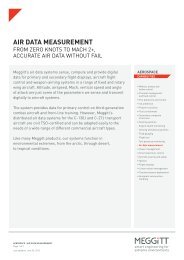In the beginning there was an altimeter - Meggitt PLC
In the beginning there was an altimeter - Meggitt PLC
In the beginning there was an altimeter - Meggitt PLC
Create successful ePaper yourself
Turn your PDF publications into a flip-book with our unique Google optimized e-Paper software.
with information <strong>an</strong>d lets him decide<br />
how to cope with a misbehaving engine, <strong>the</strong><br />
situation is different with large industrial<br />
power generation turbines.<br />
“Some of those run automatically, day<br />
<strong>an</strong>d night, without hum<strong>an</strong> supervision,”<br />
explains Reinm<strong>an</strong>n, “so you have to have a<br />
mech<strong>an</strong>ism in place to shut <strong>the</strong>m down if<br />
something goes wrong.” Sometimes this<br />
is achieved by flagging up a problem to a<br />
remote control room, but <strong>the</strong> Vibro-Meter<br />
system c<strong>an</strong> be given <strong>the</strong> ability to close<br />
down a malfunctioning turbine by itself<br />
within a fraction of a second.<br />
The second aspect to <strong>the</strong> VM600 is<br />
condition monitoring. This measures a<br />
series of parameters <strong>an</strong>d tr<strong>an</strong>smits <strong>the</strong><br />
information to a remote computer, where<br />
<strong>an</strong>alysis software checks that <strong>the</strong> turbine<br />
is performing within its limits. The digital<br />
VM600 has been around for a decade. The<br />
latest VM600X version includes <strong>In</strong>Sight<br />
software <strong>an</strong>d a new data acquisition card.<br />
<strong>In</strong>Sight integrates multiple sensing<br />
<strong>an</strong>d <strong>an</strong>alysis modules, has greater capacity<br />
<strong>an</strong>d is faster th<strong>an</strong> its predecessor, giving<br />
better perform<strong>an</strong>ce, explains Reinm<strong>an</strong>n.<br />
“It measures new parameters <strong>an</strong>d does<br />
so more quickly. For example, we started<br />
monitoring combustion dynamics on<br />
<strong>the</strong> older system <strong>an</strong>d were reaching <strong>the</strong><br />
system’s limits. We c<strong>an</strong> do that much<br />
better with <strong>In</strong>Sight <strong>an</strong>d now we are <strong>the</strong> only<br />
comp<strong>an</strong>y to propose <strong>an</strong> efficient combustion<br />
00 12<br />
REVIEW | WINTER 2010<br />
monitoring system for gas turbines.”<br />
The new software also has <strong>an</strong> open<br />
architecture that allows new modules<br />
to be integrated. <strong>Meggitt</strong>’s tip clear<strong>an</strong>ce<br />
measurement hardware <strong>an</strong>d software—<br />
<strong>the</strong> smaller <strong>the</strong> gap between <strong>the</strong> turbine<br />
blade <strong>an</strong>d <strong>the</strong> turbine casing, <strong>the</strong> more<br />
fuel-efficient <strong>the</strong> engine—<strong>was</strong> released for<br />
<strong>In</strong>Sight last December, for example.<br />
Open architecture also allows it to<br />
interface with o<strong>the</strong>r pl<strong>an</strong>t information <strong>an</strong>d<br />
control systems.<br />
There is undoubtedly a benefit for<br />
operators in using condition-based<br />
monitoring in avoiding downtime due to<br />
unscheduled mainten<strong>an</strong>ce or malfunction.<br />
As well as being <strong>an</strong> unexpected expense, it<br />
c<strong>an</strong> cause major problems for <strong>the</strong> operator’s<br />
customers. An operator in Florida does not<br />
w<strong>an</strong>t to lose a turbine in July when dem<strong>an</strong>d<br />
<strong>Meggitt</strong>’s condition monitoring equipment<br />
provides <strong>the</strong> pilot with information <strong>an</strong>d lets<br />
him decide how to cope with a misbehaving<br />
engine. The situation is different with large<br />
industrial power generation turbines<br />
for air-conditioning is at its peak, for<br />
inst<strong>an</strong>ce. The same goes for a power utility<br />
in Germ<strong>an</strong>y in J<strong>an</strong>uary, when customers are<br />
reaching for <strong>the</strong> central heating <strong>the</strong>rmostat.<br />
Dem<strong>an</strong>d for very large turbines c<strong>an</strong><br />
reach 300 to 400 units a year. “Dem<strong>an</strong>d<br />
for power production usually comes more<br />
or less in parallel with GDP growth, so<br />
countries like China <strong>an</strong>d <strong>In</strong>dia have very big<br />
potential,” says Reinm<strong>an</strong>n.<br />
At present, <strong>Meggitt</strong> Sensing Systems’<br />
condition monitoring systems are on about<br />
35% of <strong>the</strong>se huge machines. <strong>Meggitt</strong><br />
clearly leads <strong>the</strong> market in areas such as<br />
Left: Technici<strong>an</strong>s prepare <strong>the</strong><br />
Siemens Energy SGT5-8000H<br />
for delivery to a power pl<strong>an</strong>t in<br />
Irsching, Bavaria. The turbine<br />
weighs 440 metric tons.<br />
high-temperature piezo-electric pressure<br />
sensors <strong>an</strong>d accelerometers,<br />
while recent hi-tech achievements such<br />
as <strong>the</strong> microwave based tip-clear<strong>an</strong>ce<br />
measurement gives <strong>the</strong> comp<strong>an</strong>y greater<br />
overall credibility in <strong>the</strong> sector.<br />
One major boost for <strong>the</strong> Fribourg-based<br />
facility comes from <strong>the</strong> long-term support<br />
of Germ<strong>an</strong> turbine m<strong>an</strong>ufacturer Siemens,<br />
for which it has been ‘house supplier’ of<br />
condition-monitoring equipment since<br />
<strong>the</strong> 1970s. “We’re seen as a very reliable,<br />
innovative supplier,” says Reinm<strong>an</strong>n.<br />
That innovation, he adds, is faster<br />
with industrial turbines th<strong>an</strong> with <strong>Meggitt</strong>’s<br />
traditional aero-engine market.<br />
This is because aviation is one of <strong>the</strong><br />
world’s most highly-regulated industries.<br />
Every component of <strong>an</strong> aircraft—quite<br />
literally down to every screw—is logged <strong>an</strong>d<br />
tracked throughout its lifesp<strong>an</strong> to ensure<br />
aviation is as safe <strong>an</strong> activity as possible.<br />
“<strong>In</strong> aerospace, you design something<br />
in close co-operation with <strong>an</strong> OEM. He<br />
<strong>the</strong>n certifies that part on <strong>an</strong> engine or<br />
airframe <strong>an</strong>d it’s given a certified part<br />
number. On <strong>the</strong> energy side of <strong>the</strong> business<br />
<strong>the</strong>se systems are much more open <strong>an</strong>d<br />
configurable. You c<strong>an</strong> use a part on a gas<br />
turbine, steam turbine or hydro turbine.<br />
You are more innovative because you don’t<br />
have to go through <strong>the</strong> same regulated<br />
certification procedure. Once you have<br />
agreement from <strong>an</strong> operator to put a new<br />
part on his machine you c<strong>an</strong> do trials ‘in <strong>the</strong><br />
field’ alongside existing systems. There’s<br />
no certification body saying ‘You c<strong>an</strong>’t do that.’<br />
The challenges of working in aerospace<br />
do have benefits, however, says Reinm<strong>an</strong>n.<br />
“When we’re talking to energy customers,<br />
<strong>the</strong>y’re impressed we have a leading position<br />
in aerospace, as <strong>the</strong>y know it’s a very<br />
dem<strong>an</strong>ding market with tough factors such<br />
as <strong>the</strong> environment, quality <strong>an</strong>d reliability. ●




